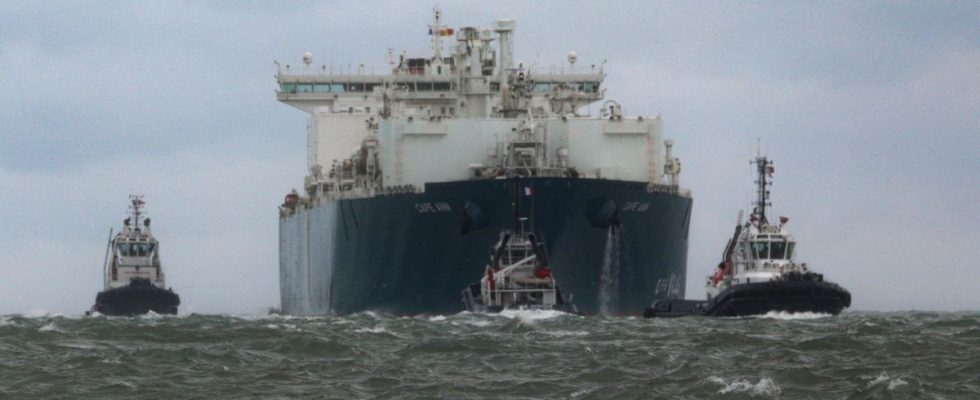Most often, the giants of the seas which dock at the port of Le Havre are not intended to stay forever. It is different for the Cape Ann. Arriving on September 18, the LNG carrier – a ship used to transport liquefied natural gas (LNG) – more than 280 m long should no longer leave the port by 2028. It must be said that the boat is not a simple LNG carrier. Its storage and regasification units make Cape Ann a floating LNG terminal… And de facto a centerpiece in the French, not to say European, energy system.
Over the next five years, ships from all over the world will come to Cape Ann, owned by TotalEnergies, unload their LNG so that it can be transformed back into a gaseous state and injected into the French gas network. This energy will be used to heat homes, move buses and trucks, produce electricity, run factories, etc.
Bringing gas from further away and from various places
A real breath of fresh air since the start of the war in Ukraine and the drastic drop in Russian gas imports into Europe? In any case, it is with a view to securing our gas supplies that the government has ordered a new gas terminal. They have the advantage of allowing, unlike gas pipelines, to transport gas from various locations and further afield.
But France already had four LNG terminals. Two in Fos-sur-Mer, near Marseille, one in Dunkirk, and a last one in Montoir-de-Bretagne (near Saint-Nazaire). All for a regasification capacity of 46.96 billion cubic meters in 2022, estimates Greenpeace France In a June report. “In France, we consume around 40 billion per year,” compares Edina Ifticene, “oil and gas” campaign manager for the NGO. With the Cape Annwe add 5 billion m³ per year of regasification capacity, or around 10% of French demand.
“A precaution” which is no longer relevant?
These LNG terminals are only one of the levers available to the government to meet its gas needs. France also has eleven storage sites, with a total capacity of 130 terawatts/hour. “That is, a little less than a third of its annual consumption,” indicates the Energy Regulatory Commission (Cre). Last year, at the request of Elisabeth Borne, these storage capacities were filled to 100% from October 5, in order to anticipate a complicated winter as much as possible. “It will be the case again this fall”, there is little doubt Anna Cretiprofessor of economics at Paris-Dauphine University and director of the Chair of Climate Economics. “There is much less uncertainty than last fall about France’s ability to meet its gas needs for the winter,” he adds.
THE Cape Ann So is it really useful? This is the question posed by Greenpeace, which tried to prevent the arrival of the ship on September 18. Edina Ifticene is already observing a change in the executive’s discourse to justify this new equipment. “We went from ‘we absolutely need this new capacity’ to ‘this is a precaution,’” she observes. Not only for France, we are told, but also for our European neighbors who need us.”
An argument that does not hold up for Edina Ifticene. “The sabotage of Nord Stream [un système de deux gazoducs entre la Russie et l’Allemagne], he is barely a year old, has created general panic in Europe, she continues. Without consulting each other, Member States have launched the construction of LNG terminals or chartered floating units like the Cape Ann. » “Germany, which had none, equipped itself with four terminals, while Poland, Italy and Spain acquired two each,” confirms Anna Creti.
The war in Ukraine, the missed opportunity to get out of gas?
At the officeAgnès Pannier-Runacher, Minister of Energy Transition, there is no question of calling into question the usefulness of this fifth terminal. “It is an additional tool to deal with all scenarios and meet the needs of the French in all circumstances,” we explain. Giving a few examples: “A very long and cold winter, a lack of supply, a breakdown”. Anna Creti mentions another risk: “the awakening of the Chinese economy and those of other Asian powers, still sluggish since Covid-19”. “This could significantly increase global demand for natural gas [et donc le prix]especially since at the same time, these countries are in a hurry to reduce their use of coal,” she explains.
Precisely, for Edina Ifticene, this is one more reason to renounce the Cape Ann. “The war in Ukraine was an opportunity to take a big step towards phasing out the fossil energy that is natural gas, we didn’t seize it.” Rather than a new terminal, she would have preferred the government to go much further on sobriety, another lever to get through the winter. “This would have been consistent with the government’s many times repeated desire – again in recent days during the presentation of ecological planning – to be one of the first Nations to move away from fossils,” points out the “oil and gas” campaign manager. gas” from the NGO.
And at the same time sobriety?
THE Cape Ann is “a temporary installation” which “does not call into question our actions and our determinations to get out of fossils”, we respond to Agnes Pannier-Runnacher’s office. We refer in particular to the “sobriety plan” detailed by Elisabeth Borne on October 6, and which “produced results that no one imagined”. Between August 1, 2022 and July 31, national gas consumption decreased by 16.3%, compared to the same period between 2018 and 2019, indicates GRTgaz, the manager of the French gas network. Or 14.3% if we take climate-corrected data, a detail which is important as last winter was mild. As a reminder, the European Union is encouraging its member states to reduce their consumption of natural gas by 15%. France is therefore in the nails… but can it do better?

